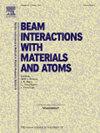Ion irradiation studies on C60 film
IF 1.4
3区 物理与天体物理
Q3 INSTRUMENTS & INSTRUMENTATION
Nuclear Instruments & Methods in Physics Research Section B-beam Interactions With Materials and Atoms
Pub Date : 2025-05-12
DOI:10.1016/j.nimb.2025.165737
引用次数: 0
Abstract
C60, also known as fullerene or buckminsterfullerene, has a variety of applications across different fields due to its unique molecular structure. Notably, C60 can be utilized in a variety of applications, including photodetectors, sensors, lubricants, and coatings. Owing to its high surface area, C60 film is particularly well-suited for chemical and biological sensors. For sensor applications, ion beams can be utilized to introduce dangling bonds and vacancies to increase efficiency in trapping molecules. Here, the irradiation response of C60 films is studied as a function of fluences of of a 100 keV helium ion beam. The C60 film is deposited on a Mica substrate via thermal evaporation of C60 powders. The as-deposited film exhibits a periodic topographical pattern formation, which was analyzed using atomic force microscopy. Upon ion irradiation, Raman spectra show an increase in the D/G mode intensity with increased fluences, consistent with previous studies on low-dimensional carbon systems. The D/G mode intensity, however, begins to decrease when damage levels are high enough to reduce the number of six-fold rings, corresponding to amorphization. The threshold amorphization fluence was measured.
离子辐照C60膜的研究
C60,也被称为富勒烯或巴克敏斯特富勒烯,由于其独特的分子结构,在不同领域有各种应用。值得注意的是,C60可用于各种应用,包括光电探测器、传感器、润滑剂和涂料。由于其高表面积,C60薄膜特别适合化学和生物传感器。对于传感器应用,离子束可以用来引入悬空键和空位,以提高捕获分子的效率。本文研究了C60薄膜的辐照响应随100 keV氦离子束辐照效应的变化规律。C60薄膜通过C60粉末的热蒸发沉积在云母衬底上。利用原子力显微镜对沉积膜进行了周期性的形貌分析。在离子辐照下,拉曼光谱显示D/G模式强度随着影响的增加而增加,这与先前对低维碳体系的研究一致。然而,当损伤程度高到足以减少六重环的数量时,D/G模式强度开始下降,这与非晶化相对应。测量了阈值非晶化影响。
本文章由计算机程序翻译,如有差异,请以英文原文为准。
求助全文
约1分钟内获得全文
求助全文
来源期刊
CiteScore
2.80
自引率
7.70%
发文量
231
审稿时长
1.9 months
期刊介绍:
Section B of Nuclear Instruments and Methods in Physics Research covers all aspects of the interaction of energetic beams with atoms, molecules and aggregate forms of matter. This includes ion beam analysis and ion beam modification of materials as well as basic data of importance for these studies. Topics of general interest include: atomic collisions in solids, particle channelling, all aspects of collision cascades, the modification of materials by energetic beams, ion implantation, irradiation - induced changes in materials, the physics and chemistry of beam interactions and the analysis of materials by all forms of energetic radiation. Modification by ion, laser and electron beams for the study of electronic materials, metals, ceramics, insulators, polymers and other important and new materials systems are included. Related studies, such as the application of ion beam analysis to biological, archaeological and geological samples as well as applications to solve problems in planetary science are also welcome. Energetic beams of interest include atomic and molecular ions, neutrons, positrons and muons, plasmas directed at surfaces, electron and photon beams, including laser treated surfaces and studies of solids by photon radiation from rotating anodes, synchrotrons, etc. In addition, the interaction between various forms of radiation and radiation-induced deposition processes are relevant.

 求助内容:
求助内容: 应助结果提醒方式:
应助结果提醒方式:


